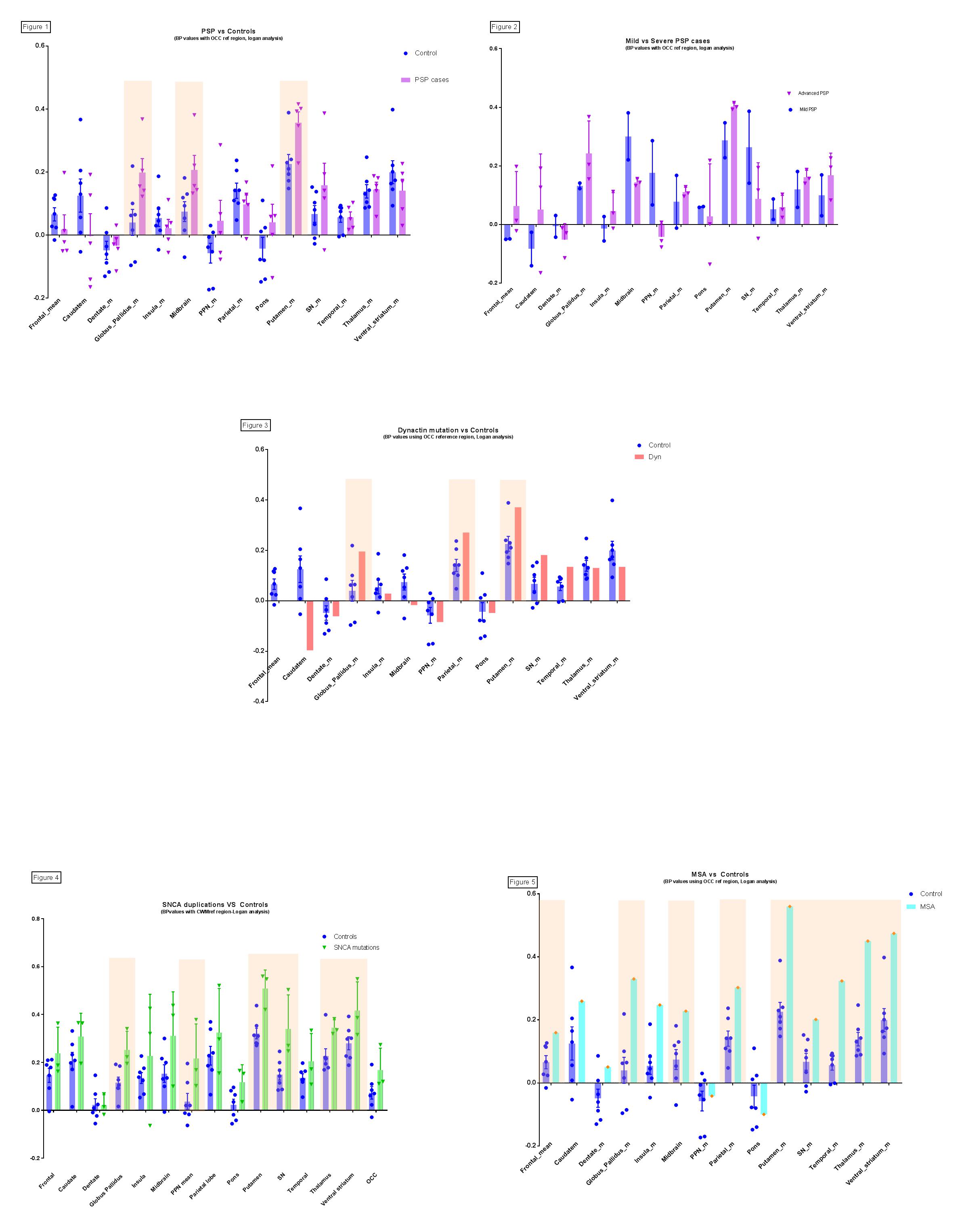Session Information
Date: Wednesday, June 7, 2017
Session Title: Neuroimaging (Non-PD)
Session Time: 1:15pm-2:45pm
Location: Exhibit Hall C
Objective: To study selective regional binding for tau pathology in vivo, using PET with [11C]PBB3 ([11C]methylamino pyridin-3-yl buta-1,3-dienyl benzo[d]thiazol-6-ol) in tauopathies, and in conditions not typically associated with -tauopathy.
Background: Tau imaging is a promising tool to study the link between tau and neurodegeneration. The specificity of tracers in vivo however remains uncertain, and off target binding is frequently present, limiting its use in parkinsonian disorders.
Methods: Dynamic PET scans were obtained for 70 min after the bolus injection of [11C]PBB3 (mean dose 518.97MBq) in five PSP subjects, 1 subject with DCTN1 mutation and PSP phenotype,3 asymptomatic SNCA duplication carriers, 1 MSA subject, and 7 healthy controls of similar age. The occipital cortex was used as reference region for the PSP , the DCTN1 mutation and the MSA subjects. The cerebellar white matter was used as a reference region for the SNCA duplication carriers. Tissue reference Logan analysis was applied to each region of interest (ROI) using the appropriate reference region.
Results: In PSP subjects, the highest retention of [11C]PBB3 was observed in putamen, midbrain, globus pallidus and substantia nigra. Longer disease duration and more advanced clinical severity were generally associated with higher tracer retention. The DCTN1/PSP phenotype case showed increased binding in putamen, parietal lobe, and globus pallidus. In SNCA duplication carriers there was a significant increase of [11C] PBB3 binding compared to controls in globus pallidus, putamen, thalamus, ventral striatum, substantia nigra, and pedunculopontine nucleus. The MSA case showed increased binding in comparison to the control group in frontal lobe, globus pallidus, midbrain, parietal lobe, putamen, temporal lobe, substantia nigra, thalamus and ventral striatum.
Conclusions: All PSP patients showed increased retention of the tracer in the basal ganglia, as clinically expected. However, binding was also present in asymptomatic SNCA duplication carriers as well as the subject with MSA, which are not typically associated with pathological tau deposition. This suggests the possibility that [11C]PBB3 binds to alpha-synuclein or other proteins involved in neurodegeneration.
To cite this abstract in AMA style:
A. Perez-Soriano, J. Arena, V. Sossi, K. Dinelle, Q. Miao, J. McKenzie, N. Neilson, A. Puschmann, P. Schaffer, H. Shinotoh, J. Smith-Forrester, E. Shahinfard, N. Vafai, D. Wile, Z. Wszolek, M. Higuchi, A.J. Stoessl. PBB3 Imaging in Parkinsonian disorders: evidence for binding to abnormally aggregated proteins in addition to tau proteins [abstract]. Mov Disord. 2017; 32 (suppl 2). https://www.mdsabstracts.org/abstract/pbb3-imaging-in-parkinsonian-disorders-evidence-for-binding-to-abnormally-aggregated-proteins-in-addition-to-tau-proteins/. Accessed December 28, 2025.« Back to 2017 International Congress
MDS Abstracts - https://www.mdsabstracts.org/abstract/pbb3-imaging-in-parkinsonian-disorders-evidence-for-binding-to-abnormally-aggregated-proteins-in-addition-to-tau-proteins/

